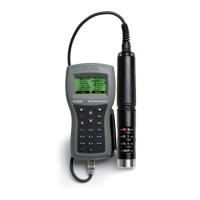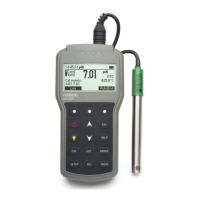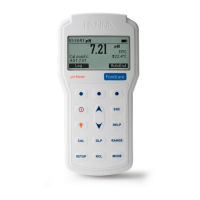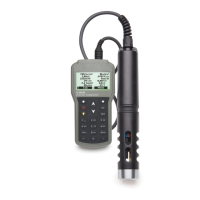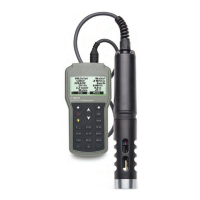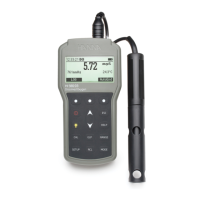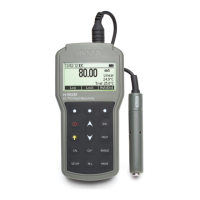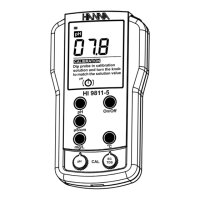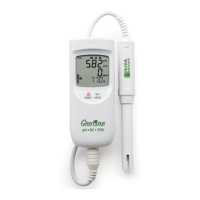Do you have a question about the Hanna Instruments HI98494 and is the answer not in the manual?
Lists the key functionalities and attributes of the HI98494 multiparameter meter.
Details the technical specifications for the HI98494 meter itself.
Details the technical specifications for the H17698494 multisensor probe.
Outlines the specifications for each type of sensor used with the probe.
Details the meter's front panel layout, including the LCD, keys, and indicators.
Describes the probe's connectors (DIN, USB-C) and its physical parts like strain relief and sensor body.
Explains the different types of sensors (pH/ORP, EC, DO) and their principles.
Provides instructions on how to prepare and condition pH/ORP and DO sensors before use.
Guides on how to physically install the sensors into the probe body using color coding.
Details general maintenance procedures and specific care for pH/ORP and DO sensors.
Explains battery types, indicators, and the procedure for replacing alkaline batteries.
Describes how to connect the multisensor probe to the meter using the DIN connector.
Outlines the procedure for powering on the HI98494 meter.
Explains how to access and use the built-in tutorial mode for guidance.
Covers basic meter operations, parameter display, and key usage.
Describes how to access the context-sensitive help menu.
Presents a visual overview of the meter's menu structure and functions.
Guides on enabling or disabling specific water quality parameters for measurement.
Explains how to set measurement units for different parameters like temperature, TDS, DO, etc.
Covers setting coefficients like EC Reference Temperature and TDS Factor.
Explains the averaging filter to minimize sensor noise and provide stable readings.
Provides essential tips and precautions for accurate sensor calibration.
Details the process for performing a quick single-point calibration for multiple sensors.
Explains how to perform pH calibration using standard or custom buffers.
Guides on performing ORP calibration using custom points or restoring factory settings.
Details procedures for calibrating DO saturation and concentration.
Explains calibration for conductivity, absolute conductivity, and salinity.
Details the process for calibrating the temperature sensor.
Guides on performing pressure calibration using a custom value.
Lists and describes the various settings available in the meter setup menu.
Details how to set up and configure the probe, including setting the Probe ID.
Displays information about battery, logging, internal temperature, and firmware.
Shows information about the connected probe, sensors, and probe firmware.
Explains how to store and recall calibration data for Good Laboratory Practice compliance.
Details how to log a single set of measurement parameters to the meter's memory.
Guides on setting the logging interval and starting an automated data log.
Explains how to view, review, and plot logged data from the meter.
Describes how to add, manage, and delete remarks for logged samples.
Explains how to connect the meter to a PC via USB to transfer logged data.
Offers best practices for probe installation and maintaining sampling sites.
Provides advice on using the product safely and effectively in specific applications.
Lists the key functionalities and attributes of the HI98494 multiparameter meter.
Details the technical specifications for the HI98494 meter itself.
Details the technical specifications for the H17698494 multisensor probe.
Outlines the specifications for each type of sensor used with the probe.
Details the meter's front panel layout, including the LCD, keys, and indicators.
Describes the probe's connectors (DIN, USB-C) and its physical parts like strain relief and sensor body.
Explains the different types of sensors (pH/ORP, EC, DO) and their principles.
Provides instructions on how to prepare and condition pH/ORP and DO sensors before use.
Guides on how to physically install the sensors into the probe body using color coding.
Details general maintenance procedures and specific care for pH/ORP and DO sensors.
Explains battery types, indicators, and the procedure for replacing alkaline batteries.
Describes how to connect the multisensor probe to the meter using the DIN connector.
Outlines the procedure for powering on the HI98494 meter.
Explains how to access and use the built-in tutorial mode for guidance.
Covers basic meter operations, parameter display, and key usage.
Describes how to access the context-sensitive help menu.
Presents a visual overview of the meter's menu structure and functions.
Guides on enabling or disabling specific water quality parameters for measurement.
Explains how to set measurement units for different parameters like temperature, TDS, DO, etc.
Covers setting coefficients like EC Reference Temperature and TDS Factor.
Explains the averaging filter to minimize sensor noise and provide stable readings.
Provides essential tips and precautions for accurate sensor calibration.
Details the process for performing a quick single-point calibration for multiple sensors.
Explains how to perform pH calibration using standard or custom buffers.
Guides on performing ORP calibration using custom points or restoring factory settings.
Details procedures for calibrating DO saturation and concentration.
Explains calibration for conductivity, absolute conductivity, and salinity.
Details the process for calibrating the temperature sensor.
Guides on performing pressure calibration using a custom value.
Lists and describes the various settings available in the meter setup menu.
Details how to set up and configure the probe, including setting the Probe ID.
Displays information about battery, logging, internal temperature, and firmware.
Shows information about the connected probe, sensors, and probe firmware.
Explains how to store and recall calibration data for Good Laboratory Practice compliance.
Details how to log a single set of measurement parameters to the meter's memory.
Guides on setting the logging interval and starting an automated data log.
Explains how to view, review, and plot logged data from the meter.
Describes how to add, manage, and delete remarks for logged samples.
Explains how to connect the meter to a PC via USB to transfer logged data.
Offers best practices for probe installation and maintaining sampling sites.
Provides advice on using the product safely and effectively in specific applications.
| Model | HI98494 |
|---|---|
| Type | Portable |
| pH Resolution | 0.01 pH |
| pH Accuracy | ±0.02 pH |
| ORP Resolution | 1 mV |
| ORP Accuracy | ±1 mV |
| Temperature Resolution | 0.1 °C |
| Dissolved Oxygen Resolution | 0.01 mg/L |
| Conductivity Accuracy | ±1% of reading |
| TDS Accuracy | ±1% of reading |
| Salinity Range | 0 to 70 ppt |
| Salinity Resolution | 0.01 ppt |
| Salinity Accuracy | ±1% of reading |
| Turbidity Accuracy | ±2% of reading |
| Ammonium Resolution | 0.01 mg/L |
| IP Rating | IP67 |
| Category | Multiparameter Meter |
| ORP Range | -1999 to 1999 mV |
| Temperature Range | -5.0 to 55.0 °C |
| Temperature Accuracy | ±0.4 °C |
| Dissolved Oxygen Accuracy | ±1.5% of reading |
| Conductivity Resolution | 0.001 mS/cm |
| Resistivity Resolution | 0.001 MΩ•cm |
| Turbidity Resolution | 0.01 NTU |
| Ammonium Accuracy | ±0.1 mg/L |
| Chloride Range | 0 to 1000 mg/L |
| Chloride Resolution | 0.1 mg/L (ppm) |
| Chloride Accuracy | ±5% of reading |
| Nitrate Resolution | 0.1 mg/L (ppm) |
| Nitrate Accuracy | ±5% of reading |
| Battery Type | 4 x AA batteries |
| Logging Memory | Up to 45, 000 data points |
| Weight | 400 g (without probe) |
| Dissolved Oxygen Range | 0.00 to 50.00 mg/L |
| Conductivity Range | 0 to 400 mS/cm |
| Turbidity Range | 0 to 1000 NTU |
| Dimensions | 185 x 93 x 37 mm |
